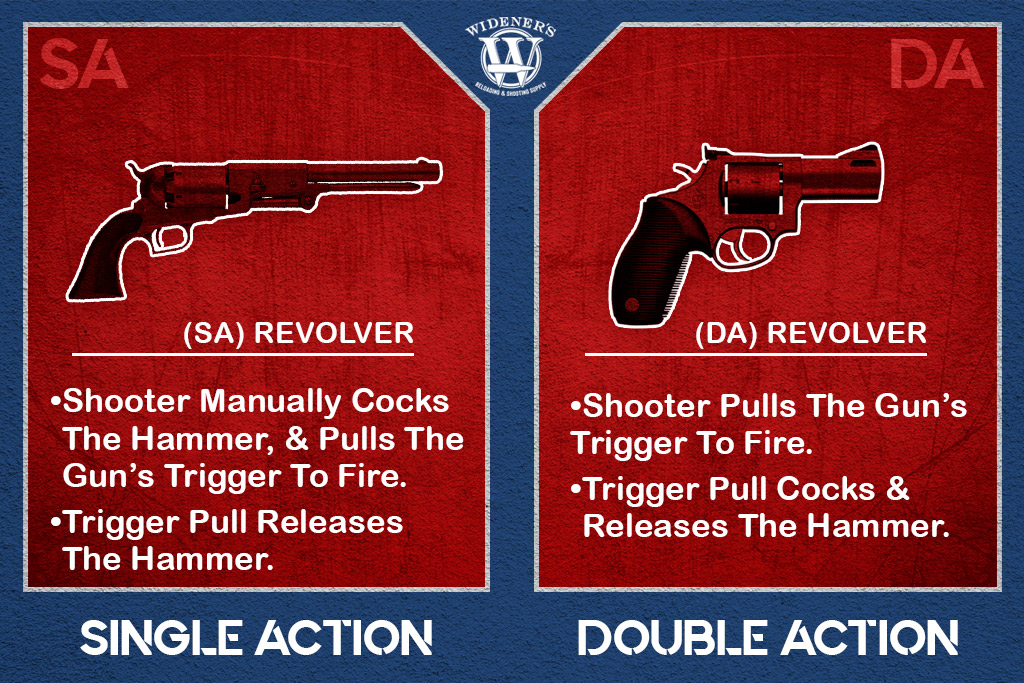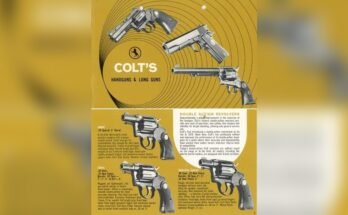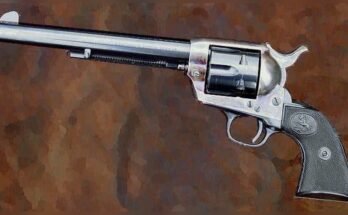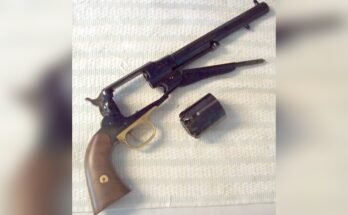Are you curious about how safe double-action revolvers really are? If you’ve ever wondered whether these classic firearms come with a built-in safety, you’re not alone.
Understanding how a double-action revolver works can give you peace of mind and help you handle it confidently. Keep reading, because the answer might surprise you—and it could change the way you think about your firearm’s safety features.

Double-action Revolver Basics
Double-action revolvers have a unique design that makes them popular among firearm users. Understanding the basics helps explain their safety features and operation. These revolvers combine firing and cocking into one smooth action. This design affects how users handle and shoot the gun.
Many people wonder if double-action revolvers have a safety mechanism. To answer, you must first know how these guns work and how they differ from other types. Let’s explore the core functions of double-action revolvers.
How Double-action Mechanism Works
In a double-action revolver, pulling the trigger does two things. It cocks the hammer and then releases it to fire the bullet. This means you do not need to manually pull back the hammer before shooting.
The trigger pull is longer and heavier than in some other guns. This adds a safety layer because it requires a deliberate pull to fire. The mechanism resets after each shot, ready for the next one.
Differences From Single-action Revolvers
Single-action revolvers work differently. You must pull back the hammer manually before each shot. The trigger only releases the hammer to fire.
This makes single-action revolvers simpler but slower to shoot. Double-action revolvers allow quicker firing without cocking each time. The heavier trigger pull on double-action adds a safety benefit. Single-action guns often have lighter triggers, making accidental shots easier.
Safety Features In Revolvers
Revolvers have built-in safety features to reduce accidental firing. These features work quietly but effectively. Understanding these helps users handle guns safely and with confidence.
Double-action revolvers rely on mechanical parts to prevent unintentional shots. The design focuses on simple, reliable safety rather than extra switches or buttons.
Common Safety Mechanisms
Most revolvers do not have a manual safety switch. Instead, they use internal mechanisms. One common feature is the hammer block. This block stops the hammer from hitting the firing pin unless the trigger is fully pulled.
Some models include a transfer bar safety. It places a metal bar between the hammer and firing pin. The bar only moves into place during trigger pull. This stops the gun from firing if dropped.
Role Of Hammer And Trigger
The hammer and trigger play key safety roles. The hammer must be cocked or the trigger fully pulled to fire. In double-action mode, pulling the trigger cocks and releases the hammer in one motion.
This long and firm trigger pull acts as a safety. It reduces chances of accidental firing. The trigger requires deliberate force, so quick, accidental shots are rare.
Do Double-action Revolvers Include Safeties?
Double-action revolvers are popular for their reliability and ease of use. Many people wonder if these guns have built-in safeties to prevent accidental firing. This question is important for anyone interested in handling or owning a double-action revolver. Understanding the safety features of these firearms can help users feel more confident and secure.
Typical Safety Designs
Most double-action revolvers do not have external manual safeties. This is different from many semi-automatic pistols. Instead, their safety relies on design features that make accidental firing unlikely. The trigger requires a firm, deliberate pull to fire. This heavy trigger pull acts as a safety measure. It prevents the gun from firing if dropped or bumped.
Internal Safety Systems
Double-action revolvers often include internal safeties. One common system is the hammer block. This blocks the hammer from striking the firing pin unless the trigger is fully pulled. Another system is the transfer bar. It only allows the hammer to hit the firing pin during a trigger pull. These internal mechanisms add layers of safety without extra switches or buttons.

Handling And Safe Practices
Handling double-action revolvers safely is very important. These guns often do not have a traditional safety switch. The safety relies on how you hold and use the revolver. Proper handling lowers the risk of accidents. It helps keep you and others safe around firearms.
Proper Carrying Methods
Always carry the revolver with the hammer down on an empty chamber if possible. Use a holster that covers the trigger guard completely. This stops anything from pressing the trigger by mistake. Keep the gun pointed in a safe direction at all times. Avoid carrying the revolver loose in a bag or pocket. Secure carrying prevents accidental firing.
Trigger Discipline Tips
Keep your finger off the trigger until ready to shoot. Rest your finger alongside the frame above the trigger guard. This simple habit prevents unintentional shots. Only place your finger on the trigger when you have full control. This ensures safer handling and reduces risks. Good trigger discipline is key for all gun users.
Comparing Safety To Semi-automatics
Comparing the safety of double-action revolvers to semi-automatic pistols reveals key differences. Both types aim to prevent accidental firing but use different methods. Understanding these distinctions helps users handle each firearm more safely.
Safety Differences
Double-action revolvers often lack manual safety switches. Instead, they rely on a heavier trigger pull to reduce accidental shots. The shooter must pull the trigger fully to fire. This built-in resistance acts as a safety feature.
Semi-automatic pistols usually include manual safeties. These safeties block the trigger or firing mechanism. Some models also have grip safeties or drop safeties. These additional features add layers of protection.
Advantages And Drawbacks
Double-action revolvers have fewer parts that can fail. Their simple design means less chance of safety mechanism failure. The heavy trigger pull also helps prevent accidental discharge.
Semi-automatics provide faster firing and easier trigger pulls. Their safeties offer more control over when the gun fires. However, more safety parts mean more potential for mechanical issues.
Choosing between these depends on user comfort and training. Both types require safe handling and respect for firearm rules.
Common Misconceptions
Many people have wrong ideas about double-action revolvers and their safety features. These misconceptions often cause confusion and fear. Understanding the truth helps users feel more confident and safe. Clear facts replace myths and build trust in these firearms.
Myths About Safety Features
Some believe double-action revolvers have no safety at all. This is not true. Instead, these guns use other safety methods. The heavy trigger pull in double-action mode acts as a safety barrier. It prevents accidental firing by requiring more force to shoot.
Another myth is that a safety switch must be present. Most revolvers do not have external safety levers. They rely on internal mechanisms and the trigger design. This system is simple yet effective in preventing unintentional shots.
Clarifying User Concerns
People worry about accidental firing without a safety switch. The truth is the revolver’s design reduces this risk. The long, stiff trigger pull lowers chances of firing by mistake. Users must pull the trigger fully to fire the gun.
Safe handling also depends on user habits. Always keeping the finger off the trigger until ready to shoot is vital. Proper training and respect for the gun make it safe to use. Understanding these points calms fears and clears doubts.

Frequently Asked Questions
Do Double-action Revolvers Have Manual Safeties?
Most double-action revolvers do not have manual safeties. They rely on heavy trigger pulls to prevent accidental firing. The design focuses on simplicity and reliability without an external safety switch.
How Do Double-action Revolvers Prevent Accidental Firing?
Double-action revolvers prevent accidental firing through a long, heavy trigger pull. This pull requires deliberate effort to fire, acting as a built-in safety mechanism without additional safeties.
Can Double-action Revolvers Be Safely Carried Loaded?
Yes, double-action revolvers can be safely carried loaded. The heavy double-action trigger pull reduces the risk of accidental discharge, making it safe for carry without manual safeties.
Are Double-action Revolvers Safer Than Semi-automatic Pistols?
Double-action revolvers offer safety through their trigger design, but not necessarily safer than semi-automatics. Safety depends on user training and handling, not just the firearm type.
Conclusion
Double-action revolvers usually do not have a manual safety. Their design relies on heavy trigger pull for safety. This makes accidental firing less likely. Users must always handle them carefully and follow gun safety rules. Knowing how your revolver works is key to staying safe.
Practice and respect make a big difference. Always treat every firearm as if it is loaded. Safety comes first, no exceptions.



